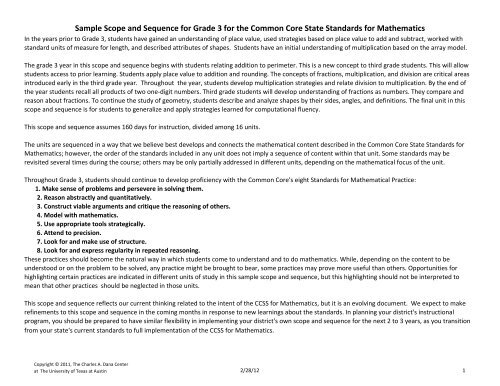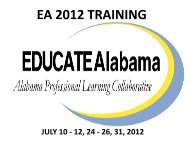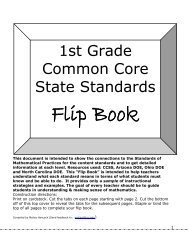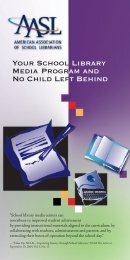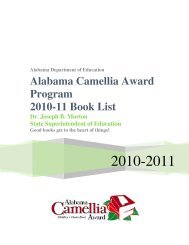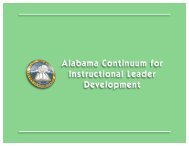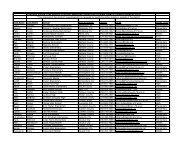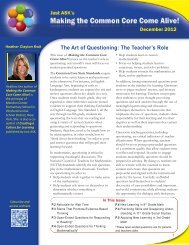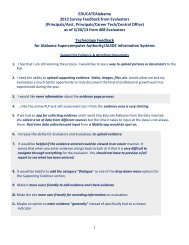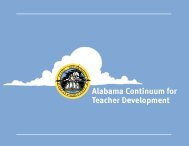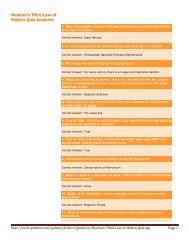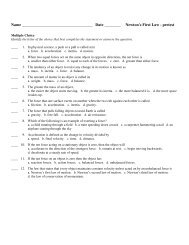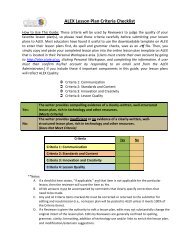Grade 3 Dana Center Scope and Sequence - Alex
Grade 3 Dana Center Scope and Sequence - Alex
Grade 3 Dana Center Scope and Sequence - Alex
Create successful ePaper yourself
Turn your PDF publications into a flip-book with our unique Google optimized e-Paper software.
Sample <strong>Scope</strong> <strong>and</strong> <strong>Sequence</strong> for <strong>Grade</strong> 3 for the Common Core State St<strong>and</strong>ards for Mathematics<br />
In the years prior to <strong>Grade</strong> 3, students have gained an underst<strong>and</strong>ing of place value, used strategies based on place value to add <strong>and</strong> subtract, worked with<br />
st<strong>and</strong>ard units of measure for length, <strong>and</strong> described attributes of shapes. Students have an initial underst<strong>and</strong>ing of multiplication based on the array model.<br />
The grade 3 year in this scope <strong>and</strong> sequence begins with students relating addition to perimeter. This is a new concept to third grade students. This will allow<br />
students access to prior learning. Students apply place value to addition <strong>and</strong> rounding. The concepts of fractions, multiplication, <strong>and</strong> division are critical areas<br />
introduced early in the third grade year. Throughout the year, students develop multiplication strategies <strong>and</strong> relate division to multiplication. By the end of<br />
the year students recall all products of two one-‐digit numbers. Third grade students will develop underst<strong>and</strong>ing of fractions as numbers. They compare <strong>and</strong><br />
reason about fractions. To continue the study of geometry, students describe <strong>and</strong> analyze shapes by their sides, angles, <strong>and</strong> definitions. The final unit in this<br />
scope <strong>and</strong> sequence is for students to generalize <strong>and</strong> apply strategies learned for computational fluency.<br />
This scope <strong>and</strong> sequence assumes 160 days for instruction, divided among 16 units.<br />
The units are sequenced in a way that we believe best develops <strong>and</strong> connects the mathematical content described in the Common Core State St<strong>and</strong>ards for<br />
Mathematics; however, the order of the st<strong>and</strong>ards included in any unit does not imply a sequence of content within that unit. Some st<strong>and</strong>ards may be<br />
revisited several times during the course; others may be only partially addressed in different units, depending on the mathematical focus of the unit.<br />
Throughout <strong>Grade</strong> 3, students should continue to develop proficiency with the Common Core's eight St<strong>and</strong>ards for Mathematical Practice:<br />
1. Make sense of problems <strong>and</strong> persevere in solving them.<br />
2. Reason abstractly <strong>and</strong> quantitatively.<br />
3. Construct viable arguments <strong>and</strong> critique the reasoning of others.<br />
4. Model with mathematics.<br />
5. Use appropriate tools strategically.<br />
6. Attend to precision.<br />
7. Look for <strong>and</strong> make use of structure.<br />
8. Look for <strong>and</strong> express regularity in repeated reasoning.<br />
These practices should become the natural way in which students come to underst<strong>and</strong> <strong>and</strong> to do mathematics. While, depending on the content to be<br />
understood or on the problem to be solved, any practice might be brought to bear, some practices may prove more useful than others. Opportunities for<br />
highlighting certain practices are indicated in different units of study in this sample scope <strong>and</strong> sequence, but this highlighting should not be interpreted to<br />
mean that other practices should be neglected in those units.<br />
This scope <strong>and</strong> sequence reflects our current thinking related to the intent of the CCSS for Mathematics, but it is an evolving document. We expect to make<br />
refinements to this scope <strong>and</strong> sequence in the coming months in response to new learnings about the st<strong>and</strong>ards. In planning your district's instructional<br />
program, you should be prepared to have similar flexibility in implementing your district's own scope <strong>and</strong> sequence for the next 2 to 3 years, as you transition<br />
from your state's current st<strong>and</strong>ards to full implementation of the CCSS for Mathematics.<br />
Copyright © 2011, The Charles A. <strong>Dana</strong> <strong>Center</strong><br />
at The University of Texas at Austin 2/28/12 1
Sample <strong>Scope</strong> <strong>and</strong> <strong>Sequence</strong> for <strong>Grade</strong> 3 for the Common Core State St<strong>and</strong>ards for Mathematics<br />
Unit St<strong>and</strong>ards for Mathematical Content St<strong>and</strong>ards for<br />
Mathematical<br />
Practice<br />
Days Comments<br />
Exploring<br />
perimeter<br />
5<br />
3.MD.8 (Solve real world <strong>and</strong> mathematical problems involving perimeters of<br />
polygons, including finding the perimeter given the side lengths, finding an unknown<br />
side length, <strong>and</strong> exhibiting rectangles with the same perimeter <strong>and</strong> different areas or<br />
with the same area <strong>and</strong> different perimeters.) [Comment]<br />
1. Make sense of problems<br />
<strong>and</strong> persevere in solving<br />
them.<br />
2. Reason abstractly <strong>and</strong><br />
quantitatively.<br />
3. Construct viable<br />
arguments <strong>and</strong> critique the<br />
reasoning of others.<br />
4. Model with mathematics.<br />
5. Use appropriate tools<br />
strategically.<br />
6. Attend to precision.<br />
7. Look for <strong>and</strong> make use of<br />
structure.<br />
8. Look for <strong>and</strong> express<br />
regularity in repeated<br />
reasoning.<br />
3.MD.8 This unit focuses on perimeter which is a new concept. Area<br />
will be addressed in the unit Investigating linear <strong>and</strong> area measures.<br />
Copyright © 2011, The Charles A. <strong>Dana</strong> <strong>Center</strong><br />
at The University of Texas at Austin 2/28/12 2
Sample <strong>Scope</strong> <strong>and</strong> <strong>Sequence</strong> for <strong>Grade</strong> 3 for the Common Core State St<strong>and</strong>ards for Mathematics<br />
Unit St<strong>and</strong>ards for Mathematical Content St<strong>and</strong>ards for<br />
Mathematical<br />
Practice<br />
Days Comments<br />
Applying place 3.OA.8 (Solve two-‐step word problems using the four operations. Represent these<br />
problems using equations with a letter st<strong>and</strong>ing for the unknown quantity. Assess the<br />
value to reasonableness of answers using mental computation <strong>and</strong> estimation strategies<br />
addition <strong>and</strong> including rounding.<br />
rounding<br />
3 )[Comment]<br />
15<br />
Developing<br />
underst<strong>and</strong>ing<br />
of fractional<br />
quantities<br />
3 This st<strong>and</strong>ard is limited to problems posed with whole numbers <strong>and</strong> having whole-‐ number answers; students<br />
should know how to perform operations in the conven-‐ tional order when there are no parentheses to specify a<br />
particular order (Order of Operations).<br />
3.OA.9 (Identify arithmetic patterns (including patterns in the addition table or<br />
multiplication table), <strong>and</strong> explain them using properties of operations. For example,<br />
observe that 4 times a number is always even, <strong>and</strong> explain why 4 times a number can<br />
be decomposed into two equal addends.)<br />
3.NBT.1 (Use place value underst<strong>and</strong>ing to round whole numbers to the nearest 10 or<br />
100.)<br />
3.NBT.2 (Fluently add <strong>and</strong> subtract within 1000 using strategies <strong>and</strong> algorithms based<br />
on place value, properties of operations, <strong>and</strong>/or the relationship between addition<br />
<strong>and</strong> subtraction.) [Comment]<br />
3.NF.1 (Underst<strong>and</strong> a fraction 1/b as the quantity formed by 1 part when a whole is<br />
partitioned into b equal parts; underst<strong>and</strong> a fraction a/b as the quantity formed by a<br />
parts of size 1/b.)<br />
3.NF.2. (Underst<strong>and</strong> a fraction as a number on the number line; represent fractions<br />
on a number line diagram.<br />
a. Represent a fraction 1/b on a number line diagram by defining the interval from 0<br />
to 1 as the whole <strong>and</strong> partitioning it into b equal parts. Recognize that each part has<br />
size 1/b <strong>and</strong> that the endpoint of the part based at 0 locates the number 1/b on the<br />
number line.<br />
b. Represent a fraction a/b on a number line diagram by marking off a lengths 1/b<br />
from 0. Recognize that the resulting interval has size a/b <strong>and</strong> that its endpoint locates<br />
the number a/b on the number line.)<br />
3.NF.3.(Explain equivalence of fractions in special cases, <strong>and</strong> compare fractions by<br />
reasoning about their size.<br />
a. Underst<strong>and</strong> two fractions as equivalent (equal) if they are the same size, or the<br />
same point on a number line.<br />
c. Express whole numbers as fractions, <strong>and</strong> recognize fractions that are equivalent to<br />
whole numbers. Examples: Express 3 in the form 3 = 3/1; recognize that 6/1 = 6;<br />
locate 4/4 <strong>and</strong> 1 at the same point of a number line diagram.)<br />
3.G.2 (Partition shapes into parts with equal areas. Express the area of each part as a<br />
unit fraction of the whole. For example, partition a shape into 4 parts with equal area,<br />
<strong>and</strong> describe the area of each part as 1/4 of the area of the shape.)<br />
1. Make sense of problems<br />
<strong>and</strong> persevere in solving<br />
them.<br />
2. Reason abstractly <strong>and</strong><br />
quantitatively.<br />
3. Construct viable<br />
arguments <strong>and</strong> critique the<br />
reasoning of others.<br />
4. Model with mathematics.<br />
5. Use appropriate tools<br />
strategically.<br />
6. Attend to precision.<br />
7. Look for <strong>and</strong> make use of<br />
structure.<br />
8. Look for <strong>and</strong> express<br />
regularity in repeated<br />
reasoning.<br />
1. Make sense of problems<br />
<strong>and</strong> persevere in solving<br />
them.<br />
2. Reason abstractly <strong>and</strong><br />
quantitatively.<br />
3. Construct viable<br />
arguments <strong>and</strong> critique the<br />
reasoning of others.<br />
4. Model with mathematics.<br />
5. Use appropriate tools<br />
strategically.<br />
6. Attend to precision.<br />
7. Look for <strong>and</strong> make use of<br />
structure.<br />
8. Look for <strong>and</strong> express<br />
regularity in repeated<br />
reasoning.<br />
3.OA.8 Solving problems involving addition <strong>and</strong> subtraction using<br />
estimation <strong>and</strong> rounding to assess reasonableness of answers is the<br />
focus in this unit.<br />
3.NBT.2 Fluency is not expected at this time.<br />
Copyright © 2011, The Charles A. <strong>Dana</strong> <strong>Center</strong><br />
at The University of Texas at Austin 2/28/12 3<br />
10
Sample <strong>Scope</strong> <strong>and</strong> <strong>Sequence</strong> for <strong>Grade</strong> 3 for the Common Core State St<strong>and</strong>ards for Mathematics<br />
Unit St<strong>and</strong>ards for Mathematical Content St<strong>and</strong>ards for<br />
Mathematical<br />
Practice<br />
Days Comments<br />
Exploring<br />
multiplication<br />
10<br />
Using addition<br />
<strong>and</strong><br />
subtraction<br />
3.MD.7. (Relate area to the operations of multiplication <strong>and</strong> addition. [Comment]<br />
a. Find the area of a rectangle with whole-‐number side lengths by tiling it, <strong>and</strong> show<br />
that the area is the same as would be found by multiplying the side lengths.<br />
b. Multiply side lengths to find areas of rectangles with whole-‐ number side lengths in<br />
the context of solving real world <strong>and</strong> mathematical problems, <strong>and</strong> represent whole-‐<br />
number products as rectangular areas in mathematical reasoning.)<br />
3.OA.5 (Apply properties of operations as strategies to multiply <strong>and</strong> divide. 2<br />
Examples: If 6 x 4 = 24 is known, then 4 x 6 = 24 is also known. (Commutative property<br />
of multiplication.) 3 x 5 x 2 can be found by 3 x 5 = 15, then 15 x 2 = 30, or by 5 x 2 =<br />
10, then 3 x 10 = 30. (Associative property of multiplication.) Knowing that 8 x 5 = 40<br />
<strong>and</strong> 8 x 2 = 16, one can find 8 x 7 as 8 x (5 + 2) = (8 x 5) + (8 x 2) = 40 + 16 = 56.<br />
(Distributive property.)) [Comment]<br />
2 Students need not use formal terms for these properties.<br />
3.OA.9<br />
3.MD.3 (Draw a scaled picture graph <strong>and</strong> a scaled bar graph to represent a data set<br />
with several categories. Solve one-‐ <strong>and</strong> two-‐step “how many more” <strong>and</strong> “how many<br />
less” problems using information presented in scaled bar graphs. For example, draw a<br />
bar graph in which each square in the bar graph might represent 5 pets.)<br />
3.NBT.1<br />
3.NBT.2 [Comment]<br />
3.OA.8<br />
3.MD.3<br />
1. Make sense of problems<br />
<strong>and</strong> persevere in solving<br />
them.<br />
2. Reason abstractly <strong>and</strong><br />
quantitatively.<br />
3. Construct viable<br />
arguments <strong>and</strong> critique the<br />
reasoning of others.<br />
4. Model with mathematics.<br />
5. Use appropriate tools<br />
strategically.<br />
6. Attend to precision.<br />
7. Look for <strong>and</strong> make use of<br />
structure.<br />
8. Look for <strong>and</strong> express<br />
regularity in repeated<br />
reasoning.<br />
1. Make sense of problems<br />
<strong>and</strong> persevere in solving<br />
them.<br />
2. Reason abstractly <strong>and</strong><br />
quantitatively.<br />
3. Construct viable<br />
arguments <strong>and</strong> critique the<br />
reasoning of others.<br />
4. Model with mathematics.<br />
5. Use appropriate tools<br />
strategically.<br />
6. Attend to precision.<br />
7. Look for <strong>and</strong> make use of<br />
structure.<br />
8. Look for <strong>and</strong> express<br />
regularity in repeated<br />
reasoning.<br />
3.MD.7, 3.OA.5 Relating multiplication to area using the<br />
commutative property is the focus of this unit.<br />
Copyright © 2011, The Charles A. <strong>Dana</strong> <strong>Center</strong><br />
at The University of Texas at Austin 2/28/12 4<br />
10<br />
3.NBT.2 Addition <strong>and</strong> subtraction to solve problems including<br />
measurement problems is the focus of this unit. Fluency is not<br />
expected at this time.
Sample <strong>Scope</strong> <strong>and</strong> <strong>Sequence</strong> for <strong>Grade</strong> 3 for the Common Core State St<strong>and</strong>ards for Mathematics<br />
Unit St<strong>and</strong>ards for Mathematical Content St<strong>and</strong>ards for<br />
Mathematical<br />
Practice<br />
Days Comments<br />
Telling time<br />
<strong>and</strong> problem<br />
solving<br />
3.MD.1 (Tell <strong>and</strong> write time to the nearest minute <strong>and</strong> measure time intervals in<br />
minutes. Solve word problems involving addition <strong>and</strong> subtraction of time intervals in<br />
minutes, e.g., by representing the problem on a number line diagram.)<br />
5<br />
Reasoning<br />
with shapes<br />
<strong>and</strong> their<br />
attributes<br />
3.G.1 (Underst<strong>and</strong> that shapes in different categories (e.g., rhombuses, rectangles,<br />
<strong>and</strong> others) may share attributes (e.g., having four sides), <strong>and</strong> that the shared<br />
attributes can define a larger category (e.g., quadrilaterals). Recognize rhombuses,<br />
rectangles, <strong>and</strong> squares as examples of quadrilaterals, <strong>and</strong> draw examples of<br />
quadrilaterals that do not belong to any of these subcategories.)<br />
1. Make sense of problems<br />
<strong>and</strong> persevere in solving<br />
them.<br />
2. Reason abstractly <strong>and</strong><br />
quantitatively.<br />
3. Construct viable<br />
arguments <strong>and</strong> critique the<br />
reasoning of others.<br />
4. Model with mathematics.<br />
5. Use appropriate tools<br />
strategically.<br />
6. Attend to precision.<br />
7. Look for <strong>and</strong> make use of<br />
structure.<br />
8. Look for <strong>and</strong> express<br />
regularity in repeated<br />
reasoning.<br />
1. Make sense of problems<br />
<strong>and</strong> persevere in solving<br />
them.<br />
2. Reason abstractly <strong>and</strong><br />
quantitatively.<br />
3. Construct viable<br />
arguments <strong>and</strong> critique the<br />
reasoning of others.<br />
4. Model with mathematics.<br />
5. Use appropriate tools<br />
strategically.<br />
6. Attend to precision.<br />
7. Look for <strong>and</strong> make use of<br />
structure.<br />
8. Look for <strong>and</strong> express<br />
regularity in repeated<br />
reasoning.<br />
Copyright © 2011, The Charles A. <strong>Dana</strong> <strong>Center</strong><br />
at The University of Texas at Austin 2/28/12 5<br />
10
Sample <strong>Scope</strong> <strong>and</strong> <strong>Sequence</strong> for <strong>Grade</strong> 3 for the Common Core State St<strong>and</strong>ards for Mathematics<br />
Unit St<strong>and</strong>ards for Mathematical Content St<strong>and</strong>ards for<br />
Mathematical<br />
Practice<br />
Days Comments<br />
Developing<br />
multiplication<br />
strategies<br />
15<br />
3.OA.1(Interpret products of whole numbers, e.g., interpret 5 x 7 as the total number<br />
of objects in 5 groups of 7 objects each. For example, describe a context in which a<br />
total number of objects can be expressed as 5 x 7.)<br />
3.OA.3 (Use multiplication <strong>and</strong> division within 100 to solve word problems in<br />
situations involving equal groups, arrays, <strong>and</strong> measurement quantities, e.g., by using<br />
drawings <strong>and</strong> equations with a symbol for the unknown number to represent the<br />
problem. 1 ) 1 See Glossary, Table 2.<br />
3.OA.5<br />
3.OA.7 (Fluently multiply <strong>and</strong> divide within 100, using strategies such as the<br />
relationship between multiplication <strong>and</strong> division (e.g., knowing that 8 x 5 = 40, one<br />
knows 40 ÷ 5 = 8) or properties of operations. By the end of <strong>Grade</strong> 3, know from<br />
memory all products of two one-‐digit numbers.) [Comment]<br />
3.NBT.3 (Multiply one-‐digit whole numbers by multiples of 10 in the range 10–90<br />
(e.g., 9 x 80, 5 x 60) using strategies based on place value <strong>and</strong> properties of<br />
operations.) [Comment]<br />
3.MD.7.<br />
c. (Use tiling to show in a concrete case that the area of a rectangle with whole-‐<br />
number side lengths a <strong>and</strong> b + c is the sum of a x b <strong>and</strong> a x c. Use area models to<br />
represent the distributive property in mathematical reasoning.)<br />
1. Make sense of problems<br />
<strong>and</strong> persevere in solving<br />
them.<br />
2. Reason abstractly <strong>and</strong><br />
quantitatively.<br />
3. Construct viable<br />
arguments <strong>and</strong> critique the<br />
reasoning of others.<br />
4. Model with mathematics.<br />
5. Use appropriate tools<br />
strategically.<br />
6. Attend to precision.<br />
7. Look for <strong>and</strong> make use of<br />
structure.<br />
8. Look for <strong>and</strong> express<br />
regularity in repeated<br />
reasoning.<br />
3.OA.7 In this unit students use the commutative property of<br />
mutiplication as a strategy to multiply.<br />
3.NBT.3 They multiply one-‐digit whole numbers by 10.<br />
Copyright © 2011, The Charles A. <strong>Dana</strong> <strong>Center</strong><br />
at The University of Texas at Austin 2/28/12 6
Sample <strong>Scope</strong> <strong>and</strong> <strong>Sequence</strong> for <strong>Grade</strong> 3 for the Common Core State St<strong>and</strong>ards for Mathematics<br />
Unit St<strong>and</strong>ards for Mathematical Content St<strong>and</strong>ards for<br />
Mathematical<br />
Practice<br />
Days Comments<br />
Solving<br />
3.MD.2 (Measure <strong>and</strong> estimate liquid volumes <strong>and</strong> masses of objects using st<strong>and</strong>ard<br />
units of grams (g), kilograms (kg), <strong>and</strong> liters (l).6 Add, subtract, multiply, or divide to<br />
problems solve one-‐step word problems involving masses or volumes that are given in the same<br />
involving mass units, e.g., by using drawings (such as a beaker with a measurement scale) to<br />
<strong>and</strong> volume represent the problem. 7 ) 7 1. Make sense of problems<br />
<strong>and</strong> persevere in solving<br />
them.<br />
10<br />
Excludes multiplicative comparison problems (problems involving notions of<br />
Measuring<br />
area <strong>and</strong><br />
relating area<br />
to operations<br />
“times as much”; see Glossary, Table 2).<br />
3.MD.5. (Recognize area as an attribute of plane figures <strong>and</strong> underst<strong>and</strong> concepts of<br />
area measurement.<br />
a. A square with side length 1 unit, called “a unit square,” is said to have “one square<br />
unit” of area, <strong>and</strong> can be used to measure area.<br />
b. A plane figure which can be covered without gaps or overlaps by n unit squares is<br />
said to have an area of n square units.)<br />
3.MD.6 (Measure areas by counting unit squares (square cm, square m, square in,<br />
square ft, <strong>and</strong> improvised units).)<br />
3.MD.7.b<br />
3.MD.7.d (Recognize area as additive. Find areas of rectilinear figures by<br />
decomposing them into non-‐overlapping rectangles <strong>and</strong> adding the areas of the non-‐<br />
overlapping parts, applying this technique to solve real world problems.)<br />
2. Reason abstractly <strong>and</strong><br />
quantitatively.<br />
3. Construct viable<br />
arguments <strong>and</strong> critique the<br />
reasoning of others.<br />
4. Model with mathematics.<br />
5. Use appropriate tools<br />
strategically.<br />
6. Attend to precision.<br />
7. Look for <strong>and</strong> make use of<br />
structure.<br />
8. Look for <strong>and</strong> express<br />
regularity in repeated<br />
reasoning.<br />
1. Make sense of problems<br />
<strong>and</strong> persevere in solving<br />
them.<br />
2. Reason abstractly <strong>and</strong><br />
quantitatively.<br />
3. Construct viable<br />
arguments <strong>and</strong> critique the<br />
reasoning of others.<br />
4. Model with mathematics.<br />
5. Use appropriate tools<br />
strategically.<br />
6. Attend to precision.<br />
7. Look for <strong>and</strong> make use of<br />
structure.<br />
8. Look for <strong>and</strong> express<br />
regularity in repeated<br />
reasoning.<br />
Copyright © 2011, The Charles A. <strong>Dana</strong> <strong>Center</strong><br />
at The University of Texas at Austin 2/28/12 7<br />
10
Sample <strong>Scope</strong> <strong>and</strong> <strong>Sequence</strong> for <strong>Grade</strong> 3 for the Common Core State St<strong>and</strong>ards for Mathematics<br />
Unit St<strong>and</strong>ards for Mathematical Content St<strong>and</strong>ards for<br />
Mathematical<br />
Practice<br />
Days Comments<br />
Exploring<br />
division <strong>and</strong><br />
relating<br />
1. Make sense of problems<br />
<strong>and</strong> persevere in solving<br />
them.<br />
2. Reason abstractly <strong>and</strong><br />
10<br />
division to<br />
multiplication<br />
quantitatively.<br />
3. Construct viable<br />
Comparing<br />
fractions with<br />
models <strong>and</strong><br />
reasoning<br />
3.OA.2 (Interpret whole-‐number quotients of whole numbers, e.g., interpret 56 ÷ 8<br />
as the number of objects in each share when 56 objects are partitioned equally into 8<br />
shares, or as a number of shares when 56 objects are partitioned into equal shares of<br />
8 objects each. For example, describe a context in which a number of shares or a<br />
number of groups can be expressed as 56 ÷ 8.)<br />
3.OA.3<br />
3.OA.4 (Determine the unknown whole number in a multiplication or division<br />
equation relating three whole numbers. For example, determine the unknown number<br />
that makes the equation true in each of the equations 8 x ? = 48, 5 = ☐ ÷ 3, 6 x 6 = ?.)<br />
3.OA.6 (Underst<strong>and</strong> division as an unknown-‐factor problem. For example, find 32 ÷ 8<br />
by finding the number that makes 32 when multiplied by 8.)<br />
3.OA.7 [Comment]<br />
3.NF.3.(Explain equivalence of fractions in special cases, <strong>and</strong> compare fractions by<br />
reasoning about their size.<br />
b. Recognize <strong>and</strong> generate simple equivalent fractions, e.g., 1/2 = 2/4, 4/6 = 2/3).<br />
Explain why the fractions are equivalent, e.g., by using a visual fraction model.<br />
d. Compare two fractions with the same numerator or the same denominator by<br />
reasoning about their size. Recognize that comparisons are valid only when the two<br />
fractions refer to the same whole. Record the results of comparisons with the<br />
symbols >, =, or
Sample <strong>Scope</strong> <strong>and</strong> <strong>Sequence</strong> for <strong>Grade</strong> 3 for the Common Core State St<strong>and</strong>ards for Mathematics<br />
Unit St<strong>and</strong>ards for Mathematical Content St<strong>and</strong>ards for<br />
Mathematical<br />
Practice<br />
Days Comments<br />
Applying 3.OA.3<br />
3.OA.5<br />
multiplication 3.OA.8 [Comment]<br />
<strong>and</strong> division to 3.NBT.3<br />
problem<br />
solving<br />
10<br />
Interpreting<br />
data with<br />
fractional<br />
amounts<br />
3.MD.4 (Generate measurement data by measuring lengths using rulers marked with<br />
halves <strong>and</strong> fourths of an inch. Show the data by making a line plot, where the<br />
horizontal scale is marked off in appropriate units— whole numbers, halves, or<br />
quarters.)<br />
1. Make sense of problems<br />
<strong>and</strong> persevere in solving<br />
them.<br />
2. Reason abstractly <strong>and</strong><br />
quantitatively.<br />
3. Construct viable<br />
arguments <strong>and</strong> critique the<br />
reasoning of others.<br />
4. Model with mathematics.<br />
5. Use appropriate tools<br />
strategically.<br />
6. Attend to precision.<br />
7. Look for <strong>and</strong> make use of<br />
structure.<br />
8. Look for <strong>and</strong> express<br />
regularity in repeated<br />
reasoning.<br />
1. Make sense of problems<br />
<strong>and</strong> persevere in solving<br />
them.<br />
2. Reason abstractly <strong>and</strong><br />
quantitatively.<br />
3. Construct viable<br />
arguments <strong>and</strong> critique the<br />
reasoning of others.<br />
4. Model with mathematics.<br />
5. Use appropriate tools<br />
strategically.<br />
6. Attend to precision.<br />
7. Look for <strong>and</strong> make use of<br />
structure.<br />
8. Look for <strong>and</strong> express<br />
regularity in repeated<br />
reasoning.<br />
3.OA.8 This unit focuses on multiplication <strong>and</strong> division.<br />
Copyright © 2011, The Charles A. <strong>Dana</strong> <strong>Center</strong><br />
at The University of Texas at Austin 2/28/12 9<br />
10
Sample <strong>Scope</strong> <strong>and</strong> <strong>Sequence</strong> for <strong>Grade</strong> 3 for the Common Core State St<strong>and</strong>ards for Mathematics<br />
Unit St<strong>and</strong>ards for Mathematical Content St<strong>and</strong>ards for<br />
Mathematical<br />
Practice<br />
Days Comments<br />
Investigating<br />
linear <strong>and</strong> area<br />
measures<br />
10<br />
Using<br />
computational<br />
fluency <strong>and</strong><br />
problem<br />
solving<br />
3.MD.8 1. Make sense of problems<br />
<strong>and</strong> persevere in solving<br />
them.<br />
2. Reason abstractly <strong>and</strong><br />
quantitatively.<br />
3. Construct viable<br />
arguments <strong>and</strong> critique the<br />
reasoning of others.<br />
4. Model with mathematics.<br />
5. Use appropriate tools<br />
strategically.<br />
6. Attend to precision.<br />
7. Look for <strong>and</strong> make use of<br />
structure.<br />
8. Look for <strong>and</strong> express<br />
regularity in repeated<br />
reasoning.<br />
3.OA.3<br />
3.OA.7<br />
3.OA.8<br />
3.NBT.2<br />
1. Make sense of problems<br />
<strong>and</strong> persevere in solving<br />
them.<br />
2. Reason abstractly <strong>and</strong><br />
quantitatively.<br />
3. Construct viable<br />
arguments <strong>and</strong> critique the<br />
reasoning of others.<br />
4. Model with mathematics.<br />
5. Use appropriate tools<br />
strategically.<br />
6. Attend to precision.<br />
7. Look for <strong>and</strong> make use of<br />
structure.<br />
8. Look for <strong>and</strong> express<br />
regularity in repeated<br />
reasoning.<br />
Copyright © 2011, The Charles A. <strong>Dana</strong> <strong>Center</strong><br />
at The University of Texas at Austin 2/28/12 10<br />
10


